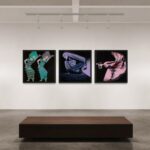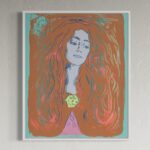So, this year has seen some pretty big changes in the ROBIN RILE family. First, Kat and I got married, much to the relief of our friends and families. While we were on our honeymoon, we had a brainchild of sorts. Because so much of our business is done via the internet, and we have not been able to meet many of our clients around the world face-to-face, we have taken to the road to meet many of you in person. Our recent jaunts have led us to New York, Atlanta, Los Angeles, Toronto and Mexico, and in the near future we have Chicago, Madrid, Barcelona, Paris and London on the radar screen. 
As a byproduct of all of this travel, we have also been able to meet with many of our vendors, publishers and friends who we have known throughout our 15 years in the art world. In the midst of a phone conversation with the head of the Salvador Dali Archives, Mr. Frank Hunter, I mentioned I would be in New York within the coming days. I was hoping he could meet up for a cup of coffee, but sadly, it was not meant to be on this trip. However, he mentioned that I should stop by Central Park to see the museum-scale works by Dali which were displayed there. He mentioned this because he knew I was part of the team which brought a collection of 41 collector and museum-scale Dali bronzes to Carlos Slim Helu’s recently-completed Museo Soumaya in Mexico City (Video Link) and I would have a special affinity for the works on display in NYC.
He was right.

When we arrived, I saw some very familiar faces indeed, including the monumental “Femme Aflame” (which is Kat’s favorite), “Space Elephant” (my fave!), “Nobility of Time”, “Profile of Time” and the Monumental “Persistence of Memory” among others. These works fill the space exquisitely and display some of Dali’s quintessential imagery, the melting clocks, the drawers, the crutches, etc. But further, they display the power of seeing these massive compositions on scale. While we are perhaps familiar with Dali’s collector-scale works in more intimate settings such as homes, seeing the museum and monumental scale works in person allows you to experience them in a completely different light. An eye-to-eye view of the master’s vision.
Dali consistently created sculptural works throughout his life and many of us are unfamiliar with his fascination with this aspect of his career. For years, I heard, “I didn’t know Dali made sculpture”, until I place a 95 lbs. bronze “Winged Triton” in front of them. Further, with the recent publication of the comprehensive catalogue raisonne of Dali sculpture, “Le Dur et le Mou” by Robert & Nicolas Descharnes, Dali works have finally been able to be quantified in the same way his paintings and prints have been over the past decades by the writings of Albert Field (Salvador Dali Archive’s original director), Ralf Michler, Fundació Gala-Salvador Dalí, Figueres and Descharnes.
Dali began experimenting with sculpture as early as 1932, when he completed “Le Soulier, objet surrealiste a fonctionnement symbolique”. While primitive, it displayed his traditional juxtaposition of elements for a dramatic effect. His intention was to shock the viewer with images which cause cognitive dissonance. This pairing of disparate elements continued in “Buste de Femme rétrospectif” (1933) and “Lobster Telephone” (1936) which used everyday objects such as bread, mannequin busts and an old telephone to create discord in the viewer’s eyes. The shock was part of the appeal to Dali and the more contrary the objects, the more disconcerting the audience would become and the more they would talk about him.

“There is only one thing in life worse than being talked about, and that is not being talked about.”
~Oscar Wilde
Through the 1960’s he experimented with classical imagery which he then updated in his own Dalinian mystique. For example taking the iconic image of the “Venus de Milo” and depreciating its image into one of historical duality; old and new, hard and soft, male and female, right and wrong. The results were some of his most celebrated works, “Otorhinological Head of Venus de Milo” and “Venus de Milo with Drawers” (see below) along with a profusion of small editions and one-of-a-kind works in all manner of media from foil to porcelain.

He returned to his proverbial roots during the 1960’s through early 1970’s while working on a sculpture collection for publisher Isidro Clot. The eponymous collection featured stream-of-conscious works constructed by Dali himself in wax maquettes then translated into bronze on multiple scales by a foundry. These works are some of the closest glimpses into the thoughts and philosophy of Dali during his “paranoic-critical” phase. During a conversation with author, authenticator and friend to Dali, Mr. Robert Descharnes in 2007, he mentioned how Dali would often sit by his pool in Southern Spain, totally nude with a glass of moscato, constructing the wax maquettes in only a few minutes as his form of haptic relaxation.

Later in life, Dali worked on a series of masterworks through his studio which tended to have a steadier hand than the aging Master. Many of these works became some of his most noted and prototypical works due to their quintessential imagery and grandiose scaling. While he often displayed “prestige-scale” works to the public, these later compositions were easily scalable to museum and monumental-scale bronzes. This is not unlike the methods of French Master Auguste Rodin (1840-1917) who often completed works on one scale only to have them reduced or enlarged based on specific client (or personally creative) needs. Rodin’s most recognized work; “The Thinker” was original completed on a scale just less than 30 inches in 1880, only to be enlarged into the more commonly-known six foot version in 1904, some 24 years later. Rodin employed a series of réducteurs, including master Henri Lebossé to produce his works on multiple scales, both larger and smaller, as needed.
The large-scale, late works from Salvador Dali are what we were in New York to see based on Mr. Hunter’s excellent recommendation. While we wished we could stay for longer and drink them in, we had other appointments to keep in the Big Apple. While we still work wholeheartedly on the placement of Dali’s monumental works from our office overlooking Miami, perhaps in London, Mexico City or Paris we might have occasion to see some of them firsthand again in the near future.
Or… Perhaps in your house?





